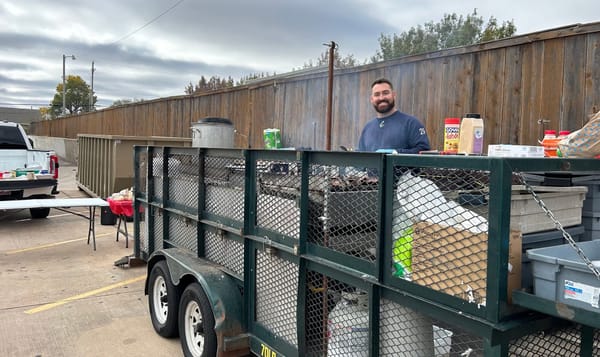How mid-sized cities are being disproportionately impacted by homelessness and what’s being done
These hubs often offer a higher quality of life compared to their surrounding municipalities, but according to officials, they also attract those who are unhoused.

The unhoused population has seen an increase across the country. However, officials are saying medium-sized cities which act as regional hubs, are being disproportionately impacted by this growth. Defined as having a population between 100,000 and 300,000, mid-sized cities like Wichita Falls, TX and Lawton, OK, act as resource epicenters for their respective areas. These hubs often offer a higher quality of life compared to their surrounding municipalities, but according to officials, they also attract those who are unhoused.
Additionally, those who are unhoused in larger, more metropolitan areas such as Dallas or Oklahoma City, are more likely to make their way to the smaller counterparts as the resources are more readily accessible.
With the influx of homelessness becoming more noticeable along these regional hubs, both aforementioned Texoma cities have recently started to take action in addressing the issue. Many nonprofit officials know it’s a hit or miss as to whether an unhoused person has any official documentation on them sharing where they recorded as residents. Because of this hurdle, it raises the question of what resources you can reserve for unhoused citizens and what is open to all.
In Wichita Falls, community members gathered by Steve Sparks, the CEO of Faith Mission, and Dr. Louis Wilson created a 60-page plan to try and address the issue. Over the past year, every entity and organization that has a hand in homelessness has been regularly meeting. This initiative was led by the citizens. After giving a presentation to county commissioners and the city council, government officials will soon be included, forming their own task-force with the goal of more structured oversight and policy driven changes.
Sparks has been working with those in need for 14 years and said homelessness has become more migratory than ever.
“Wichita Falls is beginning to see the brunt of that from the major cities,” Sparks stated. “All over Texas we’re seeing people come to Wichita Falls.”
He went on to explain Faith Mission does five to seven intakes a week and an “overwhelming” majority of those are not from Wichita Falls. Sparks also said most of them don’t take advantage of the case management services. If a person comes to Wichita Falls, Sparks wants them to be a part of society and not an addition to the unhoused population.
“Why are they coming to Wichita Falls? What are they looking for,” Sparks questioned.
According to Sparks, the city provides plenty of resources and they’ve proven the organization can help find people jobs and housing. But there’s a specific type of homelessness they’re looking to tackle, which is chronic homelessness.
Chronic homelessness deals with people who are on the streets for reasons beyond financial struggles. These are typically those who deal with mental health issues or addiction. While Sparks and everyone else involved in the “City at Home” initiative are adamant about coming at this with compassion first, and in Lawton, one organization has that part figured out.
The Salvation Army in Lawton stepped up at the end of 2024 as city officials approved an anti-camping ordinance. Captain Bryan Brinlee, who’s been working with the homeless for 30 years, decided to turn part of their property into a tent city to give those who didn’t have a place to sleep, somewhere to set up. All of Lawton’s shelters are high-barrier, meaning those who struggled with addiction weren’t permitted inside any available shelter. While having them set up across the street is convenient, they won’t always be an arms reach away.
“You have to be able to engage every homeless person in the city,” Brinlee said. “If you live in a tent under a bridge, I’m going to stay in that environment with you.”
Brinlee explained you have to rebuild the feeling of reliable community with each and every person to ensure they have the support to get themselves out of their current situation. However, Brinlee has also said he’s seen the increase in the unhoused population himself.
“Chronic homeless are there because we allow them to live there,” Brinlee said.
Accountability and resource control are two major benefactors to getting someone off the street, according to Brinlee. Similar to Wichita Falls, Lawton has a decent amount of resources, whether it be food or housing.
“Being able to control those resources has a lot to do with whether those homeless people come or they don’t,” Brinlee added. ”We have to be honest with ourselves. There is a direct correlation with the sustainability you offer and the homeless count.”
Looking at the larger picture, according to Brinlee, the United States government is handing out record amounts of money in resources while homelessness sits at an all time high.
Brinlee said a lot of current models are focused on assisting those in poverty and not those who are chronically homeless.
Since the creation of the Salvation Army’s “engage community”, the ownership of the land has been sold to a new trust authority created by the City of Lawton. Officially named the Lawton Unhoused Trust Authority, this removes the liability which was causing issues for the nonprofit to continue its current initiative.
Brinlee and Sparks believe there is an inherent responsibility that must be upheld when it comes to maintaining that regional hub status. These cities are viewed as the appropriate size for testing new initiatives and addressing growing issues.
“They have a demographic that's the perfect size to say, ‘Hey we have a model’,” Brinlee said.
While there are many things in play to address this increase in homelessness, both Brinlee and Sparks agree it needs to involve, if not start with boots on the ground, face-to-face engagement. The influx of homelessness is a pressing issue for everyone in the community and it takes everyone's involvement through providing resources, donating time or staying updated on government efforts.




